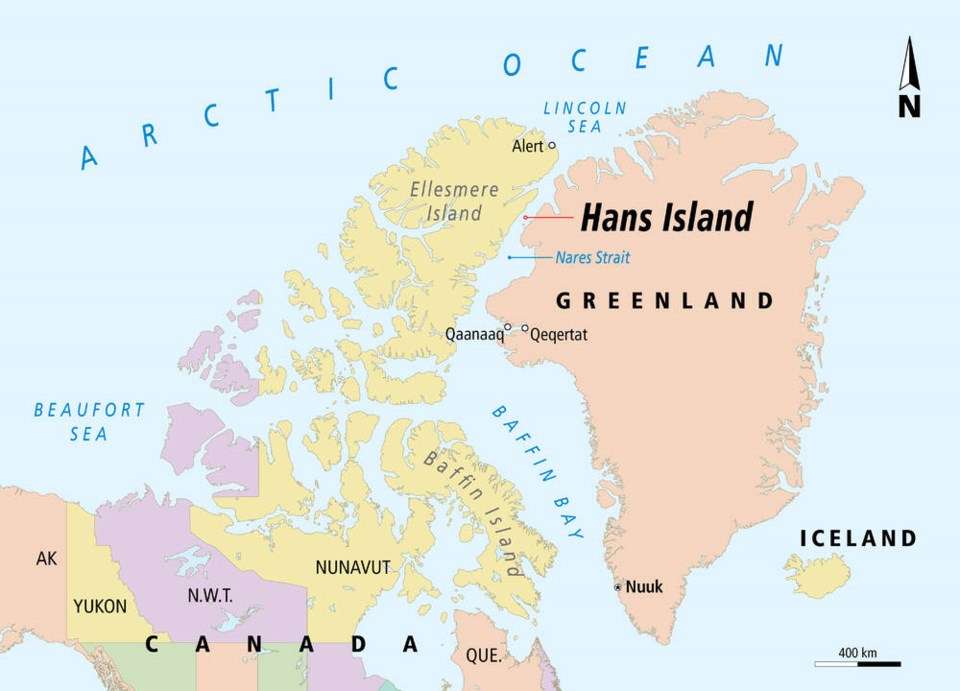News item: Reports say Canada and Denmark will to a 50-year-old dispute over who owns Hans Island, a tiny, barren, unpopulated rock in the narrow channel separating the Great White North from Greenland.
Now that the Battle of Hans Island is over, maybe it’s time to finally drop the gloves over Dixon Entrance.
Or, better yet, to refight the Pig War.
OK, the Hans Island fuss was less a battle than a long-running property-line disagreement with a neighbour many of us didn’t know we had. Still, now that it’s resolved, why not turn to other festering border disputes, including those bracketing Vancouver Island?
The Hans Island fight wasn’t really with Denmark but quasi-independent Greenland. Think of the latter as the Danish Factory Outlet Store, sitting way out on the edge of town beside Ellesmere Island and Costco.
Got to admit Canadians don’t know much about Greenland. It might be twice the size of B.C., and it might only be 15 kilometres from Canada in places, but its population of 57,000 is only half that of Saanich.
It turns out we have a history, though. The Canadian Encyclopedia references are chilling: “During the 1920s Canadian authorities became alarmed as Greenlandic Inuit hunted musk oxen on Ellesmere Island, and consequently they were hesitant about allowing Knud Rasmussen, nowadays Greenland’s foremost folk hero, to make his fact-finding trip across the Canadian Arctic lest he threaten Canadian sovereignty.”
Then, in the 1970s, came the tug-of-war over Hans Island, which both sides claimed like the last beer in the fridge.
Who knew Greenland was such a threat? We spend all our time fussing about our rambunctious neighbours to the south, yet it seems the real menace is the quiet guy upstairs, the one we never think about. (Probably has a body in the freezer.) The Greenlanders could invade us from the northeast and we wouldn’t even notice until they hit Chicoutimi.
Actually, it was Canada that got aggressive in 2005. That’s when our defence minister, Bill Graham, landed on Hans Island in a helicopter, kind of provocative-like, as though he were trying to start something. (I think I saw him put his hand on Greenland’s girlfriend’s butt, too.)
It was the sort of move you could get away with when the opponent is a lightweight like Greenland. But what about the U.S.?
For years we have been at odds with the Americans over the Beaufort Sea, over tiny Machias Seal Island (where Maine meets New Brunswick) and over whether the Northwest Passage is an international waterway or a private road.
Then there are the squabbles right here on the West Coast. Canada and the U.S. disagree over where the line is in Dixon Entrance, between Haida Gwaii and Alaska. Closer to home, there’s some slight wobbliness to the watery border off the mouth of Juan de Fuca Strait.
And right off Victoria’s front porch is San Juan Island, home to the infamous Pig War.
The Pig War was ignited 163 years ago tomorrow, on June 15, 1859. It was the culmination of a smouldering disagreement over whether the islands between Haro and Rosario straits belonged to Britain or the U.S. (Indigenous inhabitants might have had a third option, but they weren’t consulted.)
On the fateful June day in 1859, an American settler shot the trespassing pig of an Irish farmer employed by the Hudson’s Bay Co. The farmer complained to British authorities, who threatened the settler with arrest, which prompted other Americans to call for U.S. military protection, and next thing you knew things had escalated.
The U.S. landed a contingent of soldiers under the command of Capt. George Pickett (who four years later as a Confederate general would lead the disastrous Pickett’s Charge at the Battle of Gettysburg) and the British responded by sending warships. The opposing forces kept building until both benches emptied, sticks and gloves all over the ice, though nobody threw any punches.
In the end, cooler heads prevailed and it was decided to let the referees sort things out. In 1872, arbitrators led by German Emperor Wilhelm I sided with the U.S., and that was that. San Juan Island was red, white and blue. We were just blue.
Still grates, though. I say we use this Hans Island agreement as a springboard to a rematch. What could go wrong?
Or maybe we should just be glad to live in a country that doesn’t think every disagreement need lead to a fight, and where our next-door neighbour isn’t Vladimir Putin.



